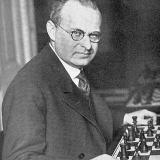Aaron Nimzowitsch Appreciation Society
This club honors the infinite figure of the master of all chess masters. Aaron Nimzowitsch is considered one of the most important players and writers in chess history.
His works influenced numerous other players, including Savielly Tartakower, Milan Vidmar, Richard Réti, Akiba Rubinstein, Bent Larsen and Tigran Petrosian, and his influence is still felt today. He wrote three books on chess strategy: Mein System (My System), 1925, Die Praxis meines Systems (The Practice of My System), 1929, commonly known as Chess Praxis, and Die Blockade (The Blockade), 1925, though much in the latter book is generally held to be a rehash of material already presented in Mein System.
Mein System is considered to be one of the most influential chess books of all time. It sets out Nimzowitsch's most important ideas, while his second most influential work, Chess Praxis, elaborates upon these ideas, adds a few new ones, and has immense value as a stimulating collection of Nimzowitsch's own games accompanied by his idiosyncratic, hyperbolic commentary which is often as entertaining as instructive.
Nimzowitsch's chess theories, when first propounded flew in the face of widely held orthodoxies enunciated by the dominant theorist of the era, Siegbert Tarrasch, and his disciples. Tarrasch's rigid generalizations drew on the earlier work of Wilhelm Steinitz, and were upheld by Tarrasch's sharp tongue when dismissing the opinions of doubters. While the greatest players of the time, among them Alekhine, Emanuel Lasker and Capablanca, clearly did not allow their play to be hobbled by blind adherence to general concepts that the center had to be controlled by pawns, that development had to happen in support of this control, that rooks always belong on open files, that wing openings were unsound—core ideas of Tarrasch's chess philosophy as popularly understood—beginners were taught to think of these generalizations as unalterable principles. Nimzowitsch supplemented many of the earlier simplistic assumptions about chess strategy by enunciating in his turn a further number of general concepts of defensive play aimed at achieving one's own goals by preventing realization of the opponent's plans. Notable in his "system" were concepts such as overprotection of pieces and pawns under attack, control of the center by pieces instead of pawns, blockading of opposing pieces (notably the passed pawns) and prophylaxis. He was also a leading exponent of the fianchetto development of bishops. Perhaps most importantly, he formulated the terminology still in use for various complex chess strategies. Others had used these ideas in practice, but he was the first to present them systematically as a lexicon of themes accompanied by extensive taxonomical observations.





